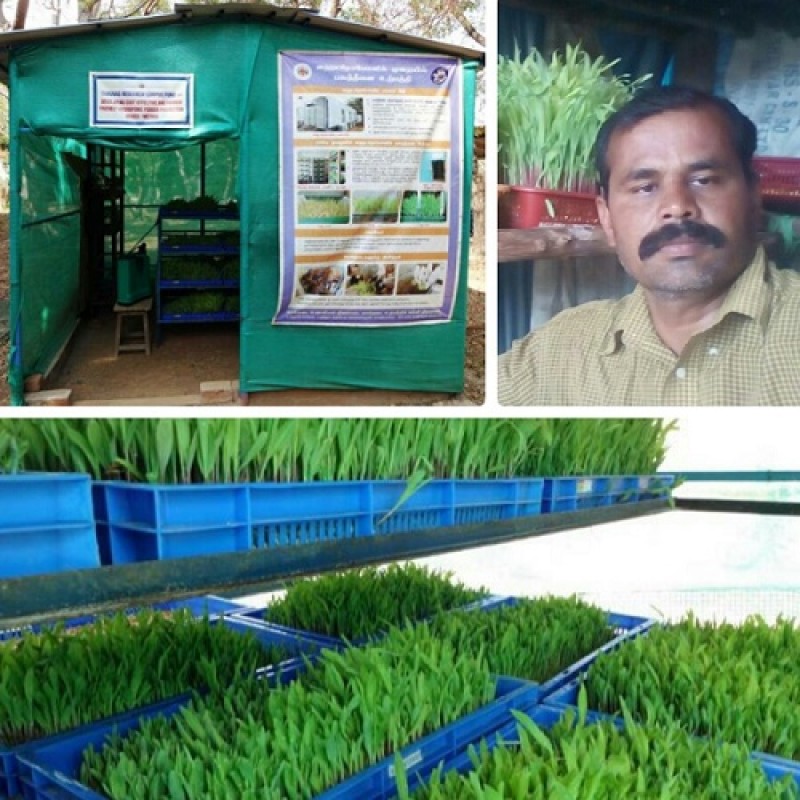
Production of low cost hydroponic maize fodder to mitigate fodder shortage for livestock during drought conditions
Pashu Sandesh, 31 May 2017
S.Gunasekaran, C.Valli and C.Bandeswaran
Institute of Animal Nutrition, Kattupakkam
Centre for Animal Production Studies
Tamil Nadu Veterinary and Animal Sciences University,Chennai - 51.
Corresponding author: gunaj2@gmail.com
Green fodder is an essential component of the dairy ration, feeding green fodder improves productive and reproductive performance of the dairy animals. Therefore, for sustainable dairy farming, quality green fodder should be fed regularly to the dairy animals (Naik et al. 2012). Conventional growing of fodder crops in soil involves large land area, more man power and huge quantity of water. Moreover, in metropolitan / sub urban areas, land is not available for fodder cultivation. Another serious problem is the availability of man power for conventional agriculture (Butler et al. 2006).
The alternative technology to increase green fodder production by vertical farming is through “hydroponic fodder production” which requires less land, less water and less man power. The term Hydroponics was derived from the Greek word ‘hydro’ meaning water and ‘ponos’ meaning labour. This system helps to overcome the challenges of climatic change and also helps in production system management for efficient utilization of natural resources and mitigating malnutrition (Butler et al. 2006).
During the period of fodder shortage animals were fed mainly with crop resides. Thus feeding green fodder through hydroponic mode of production with reduced water use can be useful in sustaining the fertility status of the animals.
The feasibility of low cost hydroponic fodder production unit suitable for rural and semi urban conditions to support landless and / or resource poor farmers having a few livestock has been studied at Institute of Animal Nutrition, Kattupakkam, Tamil Nadu Veterinary and Animal Sciences University.
Hydroponic fodder production unit
A low cost hydroponic fodder production unit in an area of 100 square feet was established at Institute of Animal Nutrition with metal sheet as roof and shade net as walls. The vertical fodder cultivation unit, in tier system has the capacity to produce 25-30 kg hydroponic fodder daily. One kilogram of maize seed can yield upto 4.0 kg of fresh hydroponic fodder. Water required to produce one kilogram of fodder is 2.20 to 2.50 litres.
The nutrient composition of hydroponic fodder maize: Crude protein - 13.38%, Crude fibre - 10.86%, ether extract - 2.82%, total ash - 2.13%, Nitrogen free extract - 70.63%.
The comparison in the protein content of hydroponic maize fodder with maize seed has been given below
|
Parameters |
Hydroponic maize fodder |
Maize seed |
|
Fresh biomass yield @ 4.0kg |
- |
|
|
Dry matter (%) |
20.0 ±0.10 |
90 |
|
Crude protein (%) |
13.04±0.91 |
9 |
|
Biomass yield in dry matter basis (g) |
800 |
900 |
|
Crude protein available to the animal (g) |
104.32 |
81 |
Increase in crude protein level by 22 % in hydroponic maize fodder compared to maize seed. It is always advantageous to feed livestock with hydroponic fodder enhanced in crude protein than feeding the partially ground maize.
|
Package of practice for establishing low cost hydroponic fodder production |
Package of practice for establishing low cost hydroponic fodder production unit was evolved and is explained below.
- Procurement of good quality maize seeds.
- Soaking of maize seeds in a plastic bucket / drum with water for 12 hours.
- This is followed by removal of water from the plastic bucket / drum and allowing the soaked seeds to sprout for 24 hours.
- Small sprouts that arise from the maize seeds are to be spread in plastic trays / crates with four to five small holes for drainage of excess water.
- The fodder can be best grown in tier system with shade net (sides) and metal sheet (roof) at a room temperature of 30 - 32ºC and relative humidity of 65 -70%.
- River sand as floor material and gunny bags moistened with water around the fodder cultivation area reduces the room temperature during summer.
- Irrigation is to be done manually for five times in a day with sprayer. Automatic sprinklers can be adopted to irrigate the fodder at timely intervals.
- The fodder will reach a height of 25 cm in 9 days excluding the days of soaking and sprouting.
- Fodder looks like a mat which comprises of root, shoot and seeds.
- About 15 kg of hydroponic fodder can be fed to a crossbred milch cow giving 8 litres of milk / day.
- Hydroponic fodder can also be fed to sheep, goat about 0.5 to 2 kg per animal per day.
The cost of conventional green fodders is Rs. 2.00 to 2.50/-.The production cost of per kg hydroponic fodder is Rs.4.50/-. In this, seed cost consumes 90 - 95% of the production cost. Even though hydroponic fodder is costlier, it can be effectively utilised for feeding animals during scarcity / drought period for sustaining production and reproduction. The farmers can adopt this technology by following the above package of practices for feeding during drought period with minimal expense on infrastructure cost.
Farmer sucess story in low cost hydroponic fodder maize cultivation
|
Farmer name |
: |
Mr. K.Senthil kumar |
|
Contact information |
: |
P.Kosavapatti, Vada Madurai, Dindugal |
|
Method |
: |
Low cost hydroponic production in an area of 8 x 8 feet: Shade net as walls, metal sheet as roofing material, wooden racks in tier system, plastic trays for fodder cultivation and automatic sprinkler device |
|
Seed utilized |
: |
Maize |
|
Biomass yield |
: |
4.40 - 5.10 kg fodder / kg of maize seed. |
|
Daily fodder production |
: |
20 kg of hydroponic maize fodder.
|
|
Cost of production |
: |
Rs.3.75 per kg fodder production. |
|
Experience on feeding hydroponic maize fodder to dairy cows |
: |
Can able to sustain milk production and its composition on partial replacement of paddy straw and conventional green fodders. |
References
Butler, J.D. and Oebker, N.F., ―Hydroponics as a Hobby— Growing Plants Without Soil‖. Circular 844. Information Office, College of Agriculture, University of Illinois, Urbana, 2006.
Naik P K, Swain B K, Chakurkar E B and Singh N P. 2012. Performance of dairy cows on green fodder maize based ration in coastal hot and humid climate. Animal Nutrition and Feed Technology 12: 265–70
S.Gunasekaran, C.Valli and C.Bandeswaran
Institute of Animal Nutrition, Kattupakkam
Centre for Animal Production Studies
Tamil Nadu Veterinary and Animal Sciences University,Chennai - 51.
Corresponding author: gunaj2@gmail.com









































































